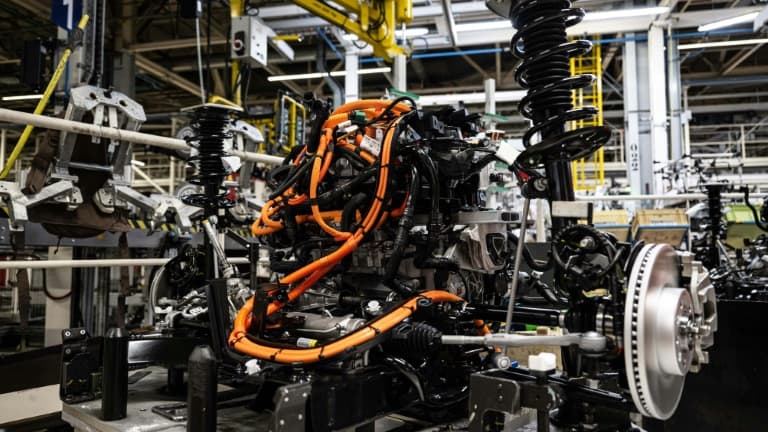Usines Auto: Relocalisation aux USA, Un Pari Risqué ?
Editor’s Note: The trend of automobile manufacturers relocating production facilities to the USA is accelerating. Is this a shrewd move or a risky gamble? This article explores the complexities of this significant shift.
Pourquoi ce sujet est-il important ?
The relocation of car manufacturing plants to the United States represents a major economic and geopolitical shift. This decision impacts not only the automotive industry but also supply chains, employment, and international trade relations. Understanding the factors driving this trend and its potential consequences is crucial for businesses, policymakers, and consumers alike. This article will examine the key drivers behind this relocation, analyzing the potential benefits and significant risks involved. We'll delve into the complexities of labor costs, infrastructure needs, political instability, and the potential impact on global competitiveness. Keywords including relocalisation, industrie automobile, États-Unis, délocalisation, risques, avantages, and supply chain will be strategically incorporated throughout the analysis.
Points clés à retenir
| Avantage | Risque |
|---|---|
| Réduction des coûts de transport | Augmentation des coûts de production |
| Accès à une main-d'œuvre qualifiée (potentiel) | Manque de main-d'œuvre qualifiée |
| Proximité aux marchés américains | Instabilité politique et réglementaire |
| Soutien gouvernemental | Concurrence accrue |
| Amélioration de l'image de marque | Risque de protectionnisme |
Usines Auto: Relocalisation aux USA
The resurgence of car manufacturing in the US isn't merely a trend; it's a strategic repositioning driven by a complex interplay of factors. The lure of the American market, the potential for reduced transportation costs, and government incentives are significant drivers. However, these benefits must be weighed against the considerable challenges.
Aspects clés de la relocalisation aux USA
- Coûts de production: While labor costs in the US may be higher than in some other countries, this is often offset by increased automation and efficiency gains.
- Infrastructures: The availability of suitable infrastructure, including transportation networks and energy supply, is paramount for successful relocation.
- Main-d'œuvre: Securing a skilled workforce is critical. Investment in training and education programs may be necessary to address potential skill gaps.
- Réglementation: Navigating the complex regulatory landscape in the US requires careful planning and compliance expertise.
- Logistique: Managing supply chains across international borders adds complexity and cost.
Analyse détaillée
Coûts de production: While wages may be higher in the US, the cost savings from reduced transportation and potential automation could offset this increase. However, a thorough cost-benefit analysis is crucial before committing to relocation. Companies need to evaluate the long-term cost implications, considering factors such as energy prices, taxes, and insurance.
Main-d'œuvre: The availability of skilled labor in specific regions is a critical factor. Relocating to areas with established automotive manufacturing expertise can minimize training costs and improve productivity. However, competition for talent can drive up wages and create workforce shortages.
Impact sur la chaîne d'approvisionnement
The shift in manufacturing will significantly impact global supply chains. Companies will need to re-evaluate their sourcing strategies, potentially relocating suppliers closer to their US production facilities. This could lead to increased costs for some components but improved responsiveness to market demands.
Impact sur l'emploi
While relocation can create jobs in the US, it may also lead to job losses in other countries. This necessitates a careful consideration of the social and economic implications. Governments and businesses need to work together to mitigate potential negative impacts through retraining and job creation programs.
Foire aux questions (FAQ)
Q1: Qu'est-ce que la relocalisation des usines automobiles aux USA ?
A1: C'est le transfert de la production automobile de pays à bas coûts vers les États-Unis.
Q2: Pourquoi les entreprises relocalisent-elles ?
A2: Pour réduire les coûts de transport, accéder à un marché plus important, bénéficier d'incitations gouvernementales, et améliorer leur image de marque.
Q3: Quels sont les risques de la relocalisation ?
A3: Coûts de production plus élevés, pénurie de main-d'œuvre qualifiée, instabilité politique et réglementaire.
Q4: Comment les entreprises peuvent-elles réussir la relocalisation ?
A4: En effectuant une analyse minutieuse des coûts, en investissant dans la formation des employés, en sécurisant un réseau d'approvisionnement fiable.
Q5: Quel est l'impact sur l'emploi ?
A5: Création d'emplois aux USA, mais potentiellement des pertes d'emplois dans d'autres pays.
Conseils pratiques pour les entreprises
- Analyse approfondie des coûts: Évaluez tous les coûts potentiels avant de prendre une décision.
- Sécurisation d'une main-d'œuvre qualifiée: Investissez dans des programmes de formation et de recrutement.
- Diversification des fournisseurs: Ne vous fiez pas à un seul fournisseur.
- Gestion des risques politiques: Soyez conscient des risques et mettez en place des plans de contingence.
- Collaboration avec les autorités locales: Obtenez le soutien des autorités locales.
Résumé
The relocation of automobile plants to the USA is a complex and multifaceted issue with both significant advantages and considerable risks. Success depends on careful planning, thorough cost-benefit analysis, and a proactive approach to managing potential challenges.
Message de clôture
The automotive industry's shift towards the US highlights the dynamic nature of global manufacturing. While the potential benefits are enticing, companies must carefully weigh the risks to ensure a successful and sustainable transition. What steps do you think are most crucial for mitigating these risks? Share your thoughts in the comments below!
Appel à l'action
Learn more about the future of automotive manufacturing by subscribing to our newsletter! Share this article to inform others about this important economic shift.

